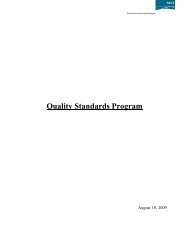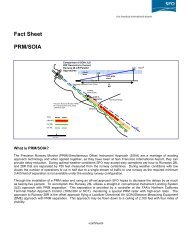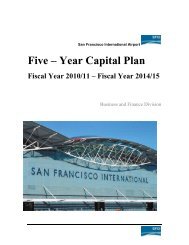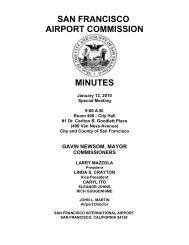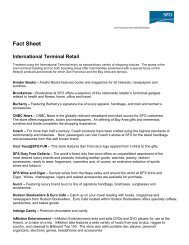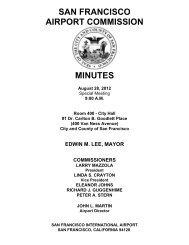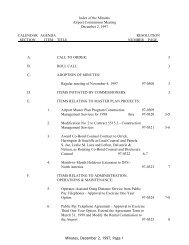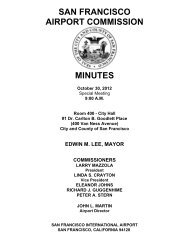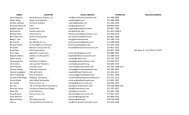Official Statement Airport Commission City and County of San ...
Official Statement Airport Commission City and County of San ...
Official Statement Airport Commission City and County of San ...
Create successful ePaper yourself
Turn your PDF publications into a flip-book with our unique Google optimized e-Paper software.
that supports all airlines in the ITC. The <strong>Airport</strong> provides technical support <strong>and</strong> assistance to the airlines 24-hours a<br />
day for the telecommunications system. See also “–<strong>Airport</strong> Security.”<br />
Other <strong>Airport</strong> Terminals. In addition to the ITC, the <strong>Airport</strong> currently has three other terminal buildings<br />
(together with the ITC, the “Terminal Complex”) consisting <strong>of</strong> approximately 2.6 million square feet <strong>of</strong> space.<br />
Terminal 1 <strong>and</strong> Terminal 3 h<strong>and</strong>le domestic flights <strong>and</strong> flights to Canada <strong>and</strong> Mexico. Terminal 2, the former<br />
international terminal, has been closed to passenger traffic for conversion to a domestic terminal to meet projected<br />
gate needs. Construction is underway <strong>and</strong> the <strong>Airport</strong> expects to reopen Terminal 2 in spring 2011. See also<br />
“–<strong>Airport</strong> Security” <strong>and</strong> “CAPITAL PROJECTS AND PLANNING.”<br />
Environmental Sustainability Program. The ACI-NA named the <strong>Airport</strong> as the 2007 recipient <strong>of</strong> the<br />
Environmental Management Award for its Environmental Sustainability Program. This program was initiated by<br />
the <strong>Airport</strong> in 2005, <strong>and</strong> seeks to reduce emissions, save energy, improve water quality, preserve natural resources<br />
<strong>and</strong> minimize waste. Specifically noted in the award were the pilot program with Virgin Atlantic Airlines to tow<br />
departing aircraft partway to the runway, the 400 Hz power <strong>and</strong> pre-conditioned air at many gates, conversion <strong>of</strong> an<br />
airport shuttle to bio-diesel fuel, installation <strong>of</strong> solar panels <strong>and</strong> a solid waste minimization <strong>and</strong> recycling program.<br />
In September 2007, 2,843 solar panels were installed on the ro<strong>of</strong>top <strong>of</strong> Terminal 3. This joint project<br />
between the <strong>Airport</strong> <strong>and</strong> the <strong>San</strong> Francisco Public Utilities <strong>Commission</strong> (the “SFPUC”) has a capacity <strong>of</strong><br />
450 kilowatts, which is enough power to provide all daytime lighting needs within Terminal 3, <strong>and</strong> generates<br />
628 kilowatt hours annually. This project was paid for with funds provided by the SFPUC Power Enterprise <strong>and</strong> is<br />
the second solar system project to be installed at the <strong>Airport</strong>. The first solar system project was a 20 kilowatt system<br />
installed on an engineering building in September 2001.<br />
On September 17, 2009, the <strong>Airport</strong> initiated the nation’s first airport based “Climate Passport” program<br />
that <strong>of</strong>fers passengers a way to easily calculate <strong>and</strong> reduce the carbon footprint <strong>of</strong> their air travel by supporting<br />
carbon <strong>of</strong>fset (also known as Verified Emission Reductions) projects based in the <strong>City</strong> <strong>and</strong> the State. Three Climate<br />
Passport kiosks are located past security in the ITC <strong>and</strong> in Terminal 3 <strong>and</strong> the Climate Passport is also available<br />
through the <strong>Airport</strong>’s website.<br />
AirTrain System. The AirTrain System provides 24-hour transit service over a “terminal loop” to serve the<br />
Terminal Complex <strong>and</strong> over a “north corridor loop” to serve the rental car facility <strong>and</strong> other locations situated north<br />
<strong>of</strong> the Terminal Complex. The AirTrain stations are located at the north <strong>and</strong> south sides <strong>of</strong> the ITC, Terminals 1, 2<br />
<strong>and</strong> 3, at the two short-term ITC parking garages, on Lot “D” to serve the rental car facility, <strong>and</strong> on McDonnell<br />
Road to serve the West Field area <strong>of</strong> the <strong>Airport</strong>.<br />
Gates<br />
The <strong>Airport</strong> has 81 operational gates, 46 <strong>of</strong> which can accommodate wide-body aircraft. 24 gates are<br />
located in the ITC, 26 in Terminal 1 <strong>and</strong> 31 are located in Terminal 3. The 10 gates in Terminal 2 are closed to<br />
passenger traffic during renovation. Terminal 2 is expected to reopen in spring 2011 with 14 gates.<br />
Forty-six <strong>of</strong> the gates in Terminal 1 <strong>and</strong> Terminal 3 are under long-term exclusive lease by six airlines<br />
pursuant to the Lease Agreements which expire June 30, 2011. See “SAN FRANCISCO INTERNATIONAL AIRPORT–<br />
Existing Airline Agreements–Lease Agreements.” The <strong>Airport</strong>’s remaining 35 operational gates are used by airlines<br />
either on a month-to-month exclusive use, common use or joint-use basis. The <strong>Airport</strong> obtained control <strong>of</strong> these 35<br />
gates by way <strong>of</strong> airline consolidation <strong>and</strong> the <strong>Airport</strong>’s buyout <strong>of</strong> airline improvements. As a result <strong>of</strong> its rights<br />
under the Lease Agreements <strong>and</strong> its control <strong>of</strong> gates which are not subject to Lease Agreements, the <strong>Airport</strong> has<br />
been able to accommodate new airlines as necessary. See “CAPITAL PROJECTS AND PLANNING.”<br />
Jet Fuel Distribution System<br />
Pursuant to a Fuel System Lease, dated as <strong>of</strong> July 1, 1997, the <strong>Airport</strong> leased its on-<strong>Airport</strong> jet fuel receipt,<br />
storage, distribution <strong>and</strong> other related facilities (collectively, the “Fuel System”) to SFO Fuel Company LLC (“SFO<br />
Fuel”). Substantially all <strong>of</strong> the airlines with regularly-scheduled service to the <strong>Airport</strong> are members <strong>of</strong> SFO Fuel.<br />
Pursuant to the Interline Agreement, the members <strong>of</strong> SFO Fuel are jointly responsible for all costs, liabilities <strong>and</strong><br />
expenses <strong>of</strong> SFO Fuel. SFO Fuel is responsible for the management <strong>and</strong> operation <strong>of</strong> the Fuel System. Operation<br />
38



